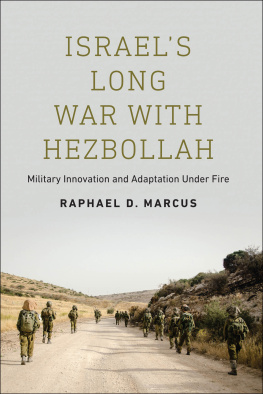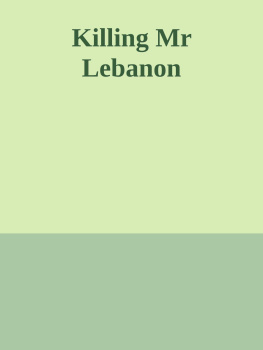War Diary:
Lebanon 2006
Rami Zurayk
Charlottesville, Virginia
Just World Books is an imprint of Just World Publishing, LLC.
All text 2011 Rami Zurayk. All rights reserved. No part of this book may be reproduced or transmitted in any form or by any means, electronic or mechanical, including photocopy, recording, or any information storage retrieval system, without permission in writing from the publisher, except brief passages for review purposes. Visit our website at www.justworldbooks.com.
Cover design and typesetting by Jane Sickon for Just World Publishing, LLC.
Printed by BookMobile, USA, and CPI, UK.
Zurayk, Rami.
War Diary: Lebanon 2006
by Rami Zurayk.
ISBN-13 for e-book: 978-1-935982-08-1
ISBN-13 for paperback: 978-1-935982-09-8
Foreword
In the summer of 2006, the Israeli military undertook a mega-lethal 33-day attack against Lebanon in pursuit of what came to be known as the Dahieh Doctrine: an attempt to inflict such dire punishment on the countrys civilian population that they wouldIsraels leaders hopedturn against the Hizbullah resistance movement once and for all. The attempt failed. Hizbullah emerged from the assault intact and with its political standing, in Lebanon and most of the Arab world, much stronger than before.
Rami Zurayk, a veteran activist from the Lebanese left and the author of Food, Farming, and Freedom: Sowing the Arab Spring , stayed in Lebanon throughout the war. He was in Beirut and in his familys home village in South Lebanon, working with other activists to relieve the suffering of the hundreds of thousands of civilians pushed out of their homes by Israels assault.
War Diary: Lebanon 2006 is the journal Zurayk kept of those 33 days. It is intimate, brutally honest, angry, impassioned, tenderand often bitingly funny. In his wry, diaristss voice he explains why so many Arab leftists are ready today to make common cause with their more Islamist compatriots as they jointly defend their societies against the attacks not just of Israel but of Western governments and publics that sometimes seem deeply hostile to Arab and Muslim aspirations.
An engaging, must-read document, War Diary: Lebanon 2006 provides much-needed context for understanding the passions and politics of the Arab Spring of 2011.
A Note on Maps
from the publisher
The World Health Organization published a detailed map, dated August 15, 2006, that showed the main dimensions inside Lebanon of the complex humanitarian crisis caused by Israels attacks. It is available online here: http://bit.ly/nIErGP.
The New York Times has an interactive map that shows the main features of the war, on both sides, as it developed day by day: http://nyti.ms/nPKSnl.
A map showing the main areas of West Beirut and some portions of the southern Beirut Dahieh can be found here: http://bit.ly/n16F5G. The Dahieh is roughly the area that stretches south and east from the Sports Arena.
A well researched map published by Human Rights Watch showed the main areas of South Lebanon that Israel hit with cluster munitionsthe vast majority of them fired after the ceasefire had been negotiated on August 11, 2006, but before it went into operation three days later. The map is on p.4 of this PDF: http://bit.ly/oTaniZ.
Authors Preface
On July 12, 2006, a unit from Lebanons Resistance led by Hizbullah attacked an Israeli patrol near the village of Aita al-Shaab in South Lebanon and captured two of the soldiers to exchange them for Lebanese prisoners in Israeli jails. This was not the first time the Resistance had captured soldiers with such a prisoner exchange in mind. But this time, Israel unleashed a war that clearly had been prepared long in advance. Lebanon was carpet-bombed from air, sea, and land. Much of its infrastructure was destroyed and most of the South as well as the Dahieh (Beiruts sprawling and heavily populated Southern suburb) were flattened. But the Israeli Army, for the first time in its history, was unable to enter Lebanon and hold its ground there. It suffered heavy losses, while causing extensivemainly civiliancasualties with the wide and frequently indiscriminate bombing campaign that it maintained throughout the 33 days of the war.
Israels military and political leaders spelled out that their principal war aim was to inflict such heavy punishment on Lebanons citizenry that the citizenry would turn against the Resistance and demand its disarming and dismantling. Some in Israel raised this concept to the level of a doctrine, which they dubbed the Dahieh Doctrine. (Most people in the international community noted that this mode of warfare, which necessarily involves intentionally inflicting harm on civilian populations, is actually a war crime.) But despite the high losses inflicted on the Lebanese population during the war the Resistance emerged intact, and therefore victorious. Indeed, the war ended up achieving exactly the opposite of what its authors had sought. The victory of the Resistance also hammered a significant nail into the coffin of George W. Bushs New Middle East.
At the time Israels government under prime minister Ehud Olmert launched the war, many Israeli commentators noted that it was also designed, more broadly, to re-establish the credibility of Israels military deterrentthe credibility of which had, they felt, been seriously dented after previous Israeli governments undertook one un-negotiated, unilateral withdrawal from South Lebanon in 2000, and another from Gaza in 2005. But the last few days of the 2006 war were, from the viewpoint of the Israeli military, a complete fiasco. Ground units sent into South Lebanon in the wars last days were ill-prepared for combat and many soon found themselves encircled and outfoxed by smart and well-prepared Resistance units. In the days after the war, Israels political discourse was marked by a loud chorus of recriminations and finger-pointing. Both the Defense Minister and the Chief of Staff were forced to resign in humiliation. Almost immediately, the new Defense Minister, Ehud Barak, started planning for another warone that would this time, he hoped, finally and definitively re-establish the credibility of Israels military deterrent. That assault, in the form of Operation Cast Lead, was duly unleashed against the population of Gaza in December 2008. Once again, the intention was to inflict such harsh punishment on the population that they would turn against their local resistance movement: in that case, Hamas. And once again, the attempt failed. Taking their inspiration in good part from the resilience that the Lebanese Resistance showed in 2006, Hamas and its partners in Gaza also survived several weeks of Israeli assault from land, sea, and air and emerged with their governance structure badly dented but still intact.
At a broader level, the Israel-Lebanon war of 2006 provided important confirmation to many in the Arab world that the weak do not have to remain so forever and that it is possible, with the appropriate preparation and alliances, to successfully defy the dominant system even when those who run that system possess and are willing to use the most lethal and destructive kinds of modern weaponry. For those of us in the Arab Left who many years earlier had become disillusioned and had stopped believing in the effectiveness of fighting the imperial ogre and in the possibility of reversing the balance of power, this was a major lesson that reverberated throughout the whole region. Five years after 2006, many of the activists who led the pro-democracy movements in Tunisia, Egypt, and elsewhere that made up the Arab Spring said that, along with the resilience shown by Palestinian resistance movements, one of the factors that inspired them to stand up to their own countries large and American-backed militaries was their memory of how the Lebanese Resistance had stood up to the Israeli military for over two decadesand most spectacularly, in 2006.













